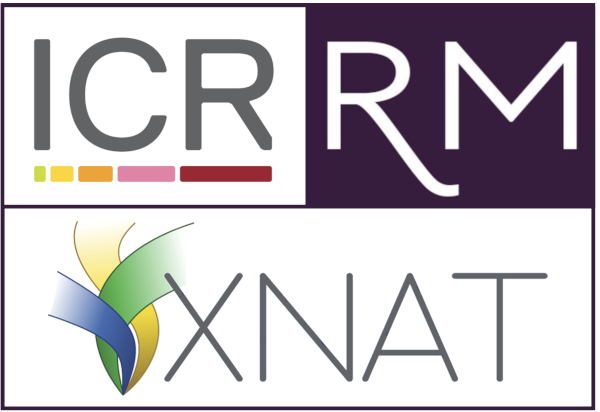Our technology: The ICR-XNAT-OHIF viewer
XNAT is an advanced management system for research images. It uses multiple technologies to provide researchers with the tools they need to process data and view data. The ICR has been at the forefront of developing new capabilities for XNAT, in particular, the ICR-XNAT-OHIF viewer (see Doran et al. Tomography 8.1 (2022). This page describes our innovations in the area of zero-footprint PACS-like image visualisation via a web browser.
In 2016, at the St Louis XNAT Workshop, Dan Marcus and Simon Doran met to discuss a significant and emerging issue with the XNAT platform. XNAT had hitherto been seen as a platform for managing images. Rudimentary image viewing capabilities were available in the form of thumbnails and a prototype viewer XImgView could be connected, but it didn’t have many features. Dan and Simon recognised that this would severely limit the attractiveness of XNAT going forwards. Both saw the opportunity, with the forthcoming release of XNAT 1.7, which for the first time, made it easy for collaborators to contribute major features, to begin a collaboration that would transform how people interacted with images on XNAT. The Institute of Cancer Research took up the challenge of incorporating the amazing open-source OHIF viewer into XNAT. Integration was not straightforward, as the XNAT and DICOM information models are significantly different, but, courtesy of talented team of front-end (James Petts and Mo Al S’ad) and back end (James Darcy) developers, we came up with an XNAT plugin that has now been downloaded more than 10,000 times and provides a PACS-like experience.
Together with other improvements to the platform, the XNAT-OHIF plugin allowed, for the first time, radiologists to interact with XNAT to report on imaging sessions and allows organisations like NCITA to run multicentre trials with distributed analysis. Here’s a quick summary of the novel features we have introduced over the years. For more detail, see our release notes. Source code and a downloadable plugin for the XNAT viewer can be found at our repository.

| Version 2.0 | Full integration of regions-of-interest. We were pioneers of bringing DICOM RT-STRUCT and DICOM-SEG into mainstream imaging research. Our work was incorporated into the TCIA platform and so is also used by non-XNAT researchers all round the world. |
| Version 3.0 | Migration to modern JavaScript React framework, introduction of 3-D MPR view and support for NVIDIA’s AI Assisted Annotation |
| Version 3.2 | Introduction of 3-D image fusion, allowing the OHIF viewer to display PET-CT for the first time, for example |
| Version 3.3 | Contour lazy loading, improved rendering and significant upgrade to contour panel features |
| Version 3.4 | A new measurement service for XNAT, which allows researchers not just to see their annotations on-screen, but also saves quantitative measurements in machine-readable form. This allows trials to be run capturing RECIST data, for example. |
| Version 3.5 | Visualisation of contours in arbitrary 3-D planes |
| Version 3.6 | Multistack view for 4-D data. View MR images with multiple slices and multiple echo times or multiple b-values in a coherent and easy-to-navigate way. |
| Version 3.7 (forthcoming) | Support for digital pathology images |
The ICR-XNAT-OHIF viewer and artificial intelligence (AI)
The XNAT-OHIF viewer has been designed as a platform on which artificial intelligence tools can be deployed, as long as you can do a bit of coding. One of the first applications we looked at was the implementation of NVIDIA’s AI-Assisted Annotation (AIAA). This comes with some built in algorithms that give a flavour of what can be done. More algorithms both designed by the MONAI team and contributed by the open-source community are available at the MONAI model zoo website. Or you can build your own. Detailed instructions on how to install AIAA with the ICR-XNAT-OHIF viewer plugin can be found here.
The plugin is also compatible with inference in MONAI Label, which is NVIDIA’s successor to the original Clara toolkit on which AIAA is based.
ICR-XNAT-OHIF viewer training course
The NCITA Repository Unit Team has put together a set of video-based training material that describes all the main features of the OHIF viewer (up to version 3.1.0). This is best accessed via the XNAT Academy – be sure to choose the OHIF viewer v3 (not v2!) course – where enrolment is free and full transcripts of each lesson are available. However, for ease of reference, here are all the videos collected together. Unfortunately, the most recent developments of the viewer don’t yet have lessons associated with them.

